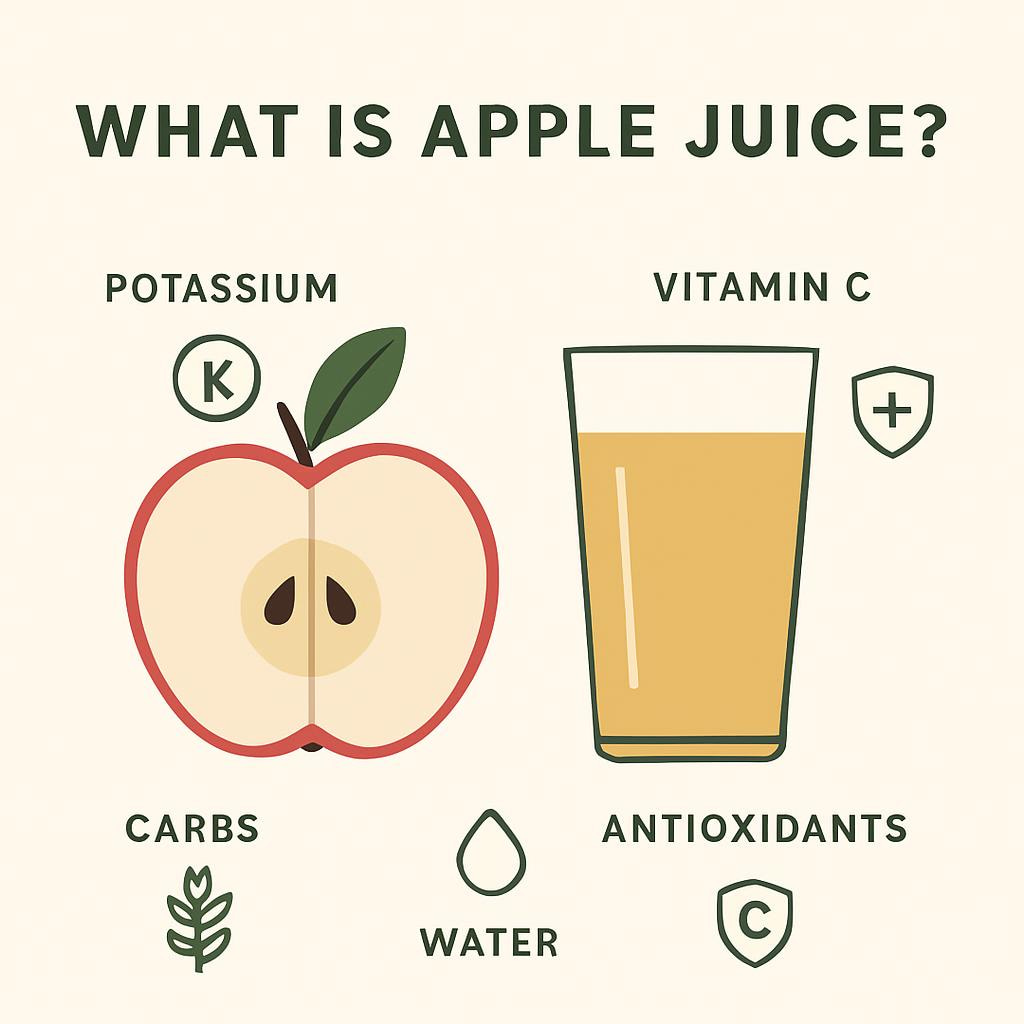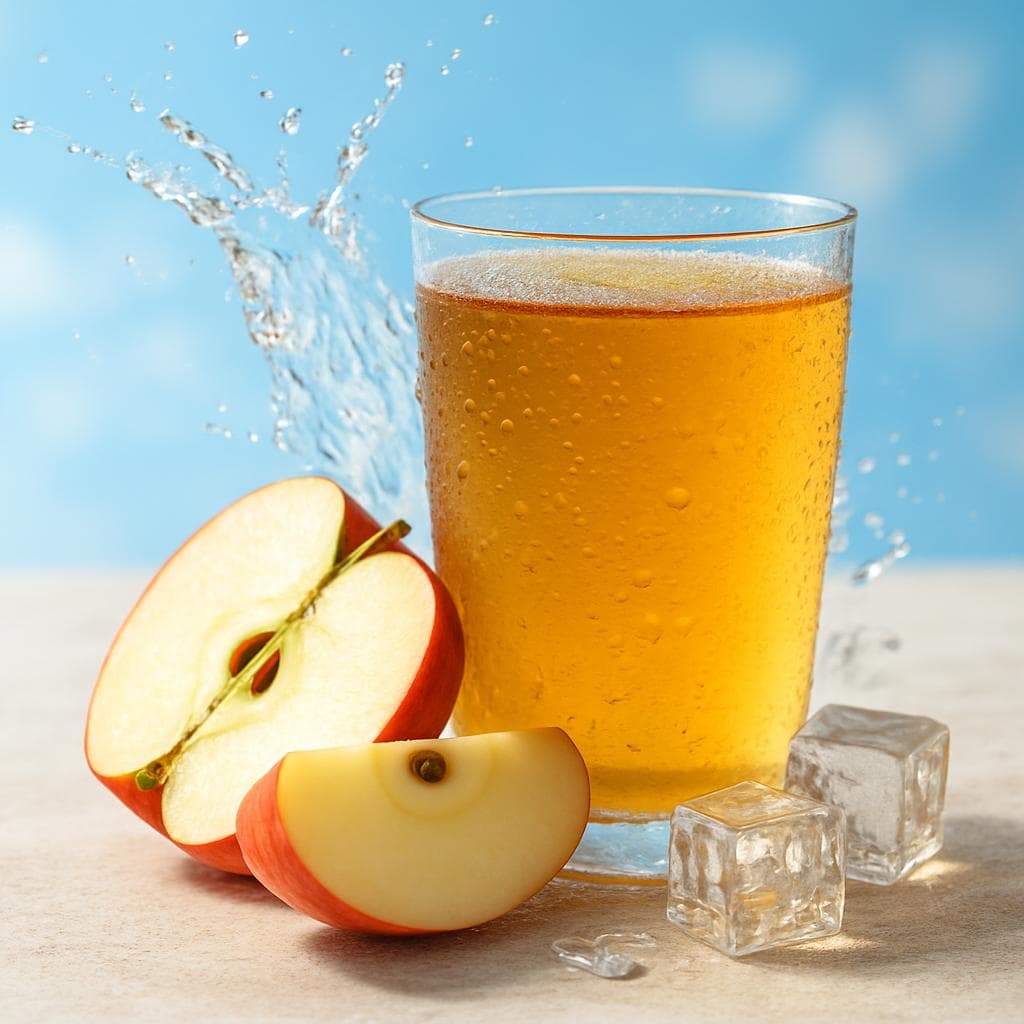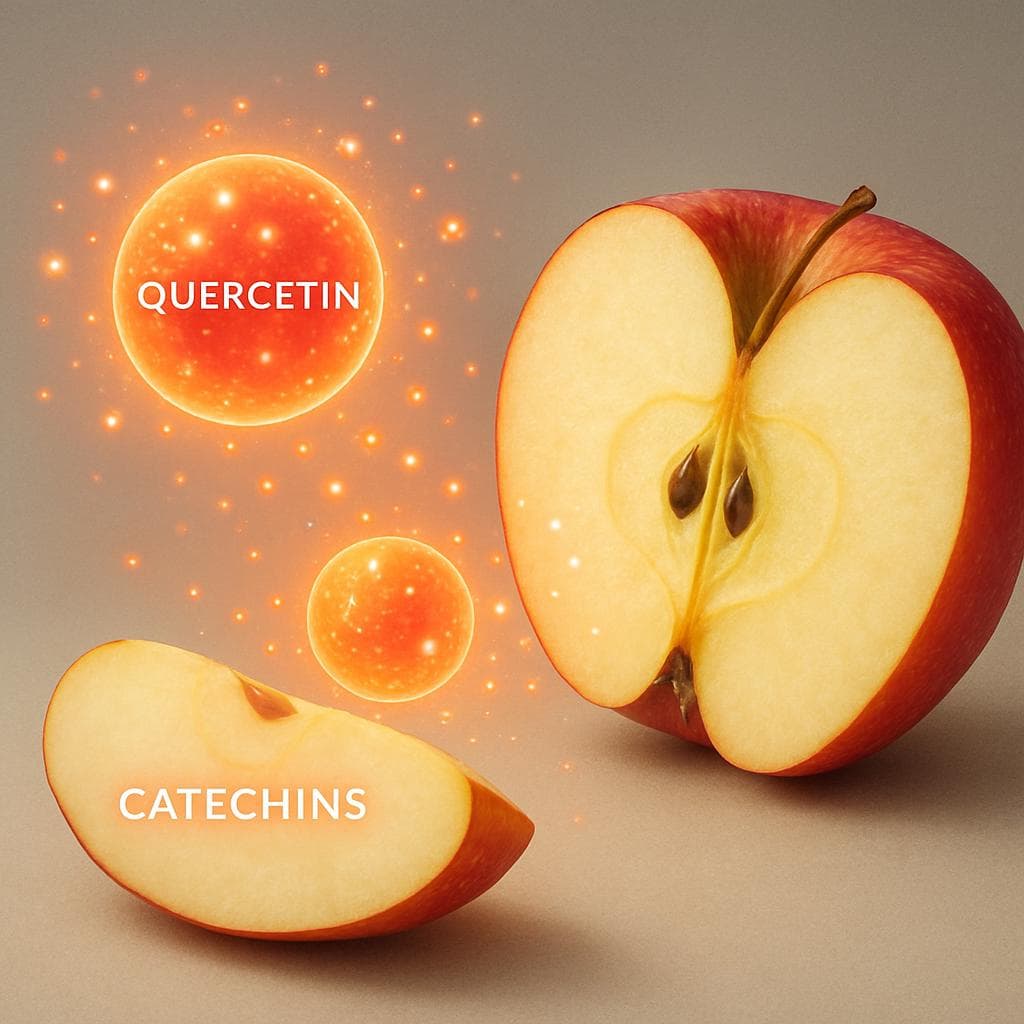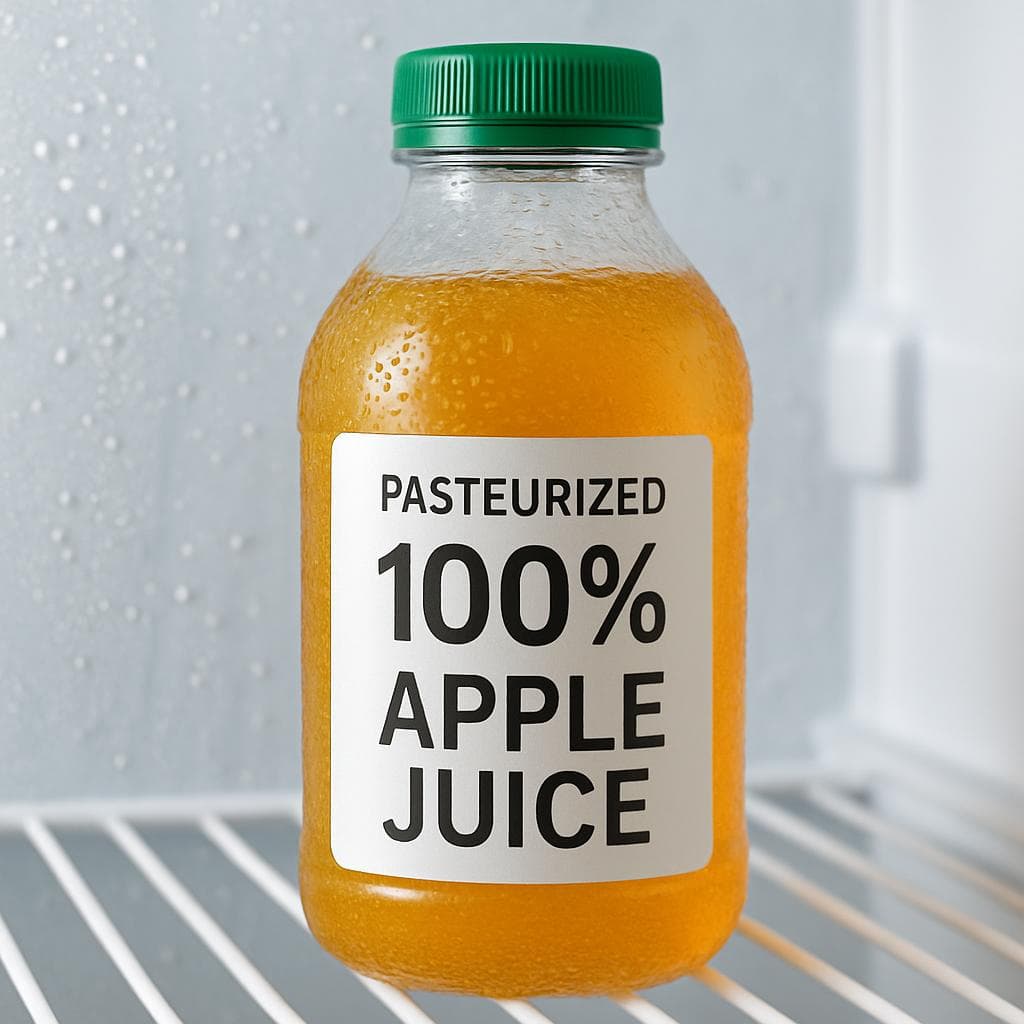Apple juice may support hydration, provide antioxidants, and offer essential nutrients like potassium that promote overall wellness when consumed in moderation. Understanding its benefits and potential drawbacks helps you make smarter nutrition choices. This guide explains the science-backed advantages of apple juice, how to enjoy it safely, and what to look for when buying.

What Is Apple Juice? (Overview and Nutrition Profile)
Apple juice is a sweet, refreshing beverage made by pressing or extracting liquid from fresh apples. It is one of the most popular fruit juices worldwide, valued for its crisp flavor, natural sugars, and hydrating properties. Depending on processing, apple juice is sold in two main forms:
- Clear apple juice – filtered and pasteurized to remove pulp; smooth and transparent but lower in antioxidants.
- Cloudy apple juice – unfiltered and contains fine apple solids, which retain more polyphenols (antioxidant plant compounds) and dietary nutrients.
The juice’s flavor and nutrient density can vary based on apple variety, processing method, and whether it’s fresh-pressed, from concentrate, or fortified with vitamins like vitamin C.

Nutritional Profile (Per 1 Cup / 240 mL, 100% Apple Juice)
(Based on USDA FoodData Central, 2025)
| Nutrient | Amount | % Daily Value (Approx.) |
|---|---|---|
| Calories | 114 kcal | — |
| Total Carbohydrates | 28 g | 10% |
| Total Sugars | 24 g (naturally occurring fructose + glucose) | — |
| Dietary Fiber | < 0.5 g | 1% |
| Protein | 0.2 g | — |
| Fat | 0 g | — |
| Potassium | 250–310 mg | 5–7% |
| Sodium | 10 mg | — |
| Vitamin C* | 60–90 mg (if fortified) | 67–100% |
*Vitamin C content varies significantly; unfortified juice provides minimal amounts, while fortified commercial brands can meet daily needs.
Key Nutritional Insights
- Apple juice is 88% water, making it an excellent hydration source.
- It contains natural fruit sugars that provide quick energy.
- Cloudy juice retains more antioxidants and phytochemicals.
- It is low in fiber and protein, so pairing it with whole grains or nuts may balance blood sugar levels.
- Fortified varieties may provide meaningful amounts of vitamin C for immune support.
For the most accurate and updated nutrition data, refer to USDA FoodData Central – Apple Juice, 100%.
10 Proven Health Benefits of Apple Juice (Backed by Science)
Apple juice offers hydration, natural energy, and essential nutrients that can support overall wellness when consumed in moderation. Below are ten evidence-based benefits, each backed by scientific research and authoritative health sources.
1. Supports Hydration

Apple juice is approximately 88% water, making it a hydrating beverage that may help maintain the body’s fluid balance. For those who dislike plain water, a small serving of juice can be a practical alternative. Its mild sweetness provides quick energy during light activity or recovery from mild illness.
Tip: Choose unsweetened 100% apple juice to avoid added sugars that can counteract hydration benefits.
Reference: Harvard Health Publishing – The Importance of Hydration
2. Provides Potassium for Heart and Muscle Function

Potassium is an essential mineral that supports heart rhythm, nerve transmission, and muscle contraction. A cup of 100% apple juice provides approximately 250–310 mg of potassium—about 5–7% of the daily value. Regular potassium intake may support healthy blood pressure levels and reduce the strain on blood vessel walls.
Including potassium-rich beverages like apple juice in moderation can contribute to electrolyte balance, particularly after sweating or exercise.
Reference: Harvard T.H. Chan School of Public Health – Potassium
3. Contains Antioxidant Plant Compounds

Apples are naturally rich in polyphenols, including quercetin, chlorogenic acid, catechins, and phloridzin—compounds known to help neutralize oxidative stress in the body. Cloudy apple juice retains more of these antioxidants compared to clear filtered varieties, which lose a significant amount during processing.
Regular intake of polyphenol-rich foods may support cardiovascular and cellular health by combating oxidative damage.
Reference: Journal of Agricultural and Food Chemistry (2023)
4. Supports Digestive Comfort (in Moderation)

Apple juice contains sorbitol and fructose, natural sugars that can draw water into the intestines and support gentle bowel regularity for some people. However, excessive consumption can lead to bloating, gas, or discomfort—particularly in children with fructose malabsorption.
For digestive comfort, enjoy small servings (½ cup) and observe your body’s tolerance.
Reference: Cleveland Clinic – Sorbitol and Digestive Health
5. Offers Quick Energy Boost

Because apple juice contains natural simple carbohydrates, it may provide a fast source of energy before or after physical activity. Athletes or individuals recovering from light fatigue can use a small serving to restore glycogen and hydration levels. Pairing it with protein or fiber-rich foods (like nuts or yogurt) helps balance blood sugar response.
Reference: Mayo Clinic – Carbohydrates and Energy
6. May Support Immune Health (Fortified Varieties)

Many commercial apple juices are fortified with vitamin C, a vital antioxidant that supports immune defense, collagen formation, and wound healing. Fortified versions can provide up to 100% of the daily vitamin C requirement per cup.
Vitamin C supports white blood cell function and helps protect cells from environmental stressors.
Reference: National Institutes of Health – Vitamin C Fact Sheet
7. Gentle Option During Mild Illness

When appetite is low or solid foods are difficult to consume, diluted apple juice can serve as a gentle hydration source and provide easily digestible carbohydrates. For individuals recovering from mild illness, especially children with minor dehydration from vomiting or diarrhea, it offers both fluid and energy replenishment in a well-tolerated form.
A randomized clinical trial published in JAMA Pediatrics (2016) found that diluted apple juice followed by preferred fluids was as effective as oral rehydration solutions for treating mild dehydration in children with gastroenteritis. The study, which included 647 children aged 6 months to 5 years, reported a lower treatment failure rate (16.7%) in the apple juice group compared to the electrolyte solution group (25%). Researchers concluded that the natural sugars, electrolytes, and high palatability of apple juice made it a practical, cost-effective option for mild cases of dehydration under supervision.
Important: This approach is suitable only for mild dehydration and should not replace medical treatment for moderate or severe cases. Infants under 6 months or individuals with chronic health conditions should seek professional guidance before using juice-based hydration methods.
Reference: Freedman SB, et al. Effect of Dilute Apple Juice and Preferred Fluids vs Electrolyte Maintenance Solution on Treatment Failure Among Children With Mild Gastroenteritis: A Randomized Clinical Trial. JAMA Pediatrics, 2016;315(18):1966–1974.
8. May Support Iron Absorption

If vitamin C–fortified apple juice is paired with iron-rich plant foods—such as spinach, beans, or lentils—it may support non-heme iron absorption. Vitamin C plays a crucial role in converting plant-based iron into a more bioavailable form, allowing the body to absorb it more efficiently. This nutrient synergy can be particularly beneficial for vegetarians, vegans, or individuals at risk of low iron levels.
According to the Harvard T.H. Chan School of Public Health’s Nutrition Source, vitamin C “improves the absorption of non-heme iron, the type of iron found in plant foods such as leafy greens.” Consuming vitamin C–fortified beverages like apple juice with meals that include legumes or grains may therefore enhance total iron uptake and help maintain healthy energy and oxygen transport throughout the body.
Tip: Combine apple juice (fortified with vitamin C) with breakfast cereals, oatmeal, or iron-rich salads to optimize absorption naturally.
References:
- Harvard T.H. Chan School of Public Health – Vitamin C
- Harvard T.H. Chan School of Public Health – Iron
9. Kid-Friendly Beverage — Within Limits

According to the American Academy of Pediatrics (AAP), 100% apple juice can be part of a child’s diet when served in limited amounts:
- Ages 1–3 years: up to 4 oz/day
- Ages 4–6 years: 4–6 oz/day
- Ages 7–18 years: up to 8 oz/day
Infants under 12 months should avoid juice entirely. Whole apples are always the preferred choice for fiber, fullness, and nutrient density.
Reference: American Academy of Pediatrics – Fruit Juice Guidelines
10. Supports Food Safety Awareness

Choosing pasteurized apple juice is essential for protecting against foodborne illnesses caused by harmful bacteria such as E. coli O157:H7 and Salmonella. Unpasteurized or “raw” juices can harbor these pathogens, which have been linked to serious outbreaks in the past—most notably the 1996 Odwalla incident involving contaminated unpasteurized apple juice.
According to the U.S. Food and Drug Administration (FDA), consumers should “only drink those juices that have been pasteurized or otherwise treated to kill harmful bacteria” and always check product labels carefully. Federal regulations (21 CFR Part 120) require that unpasteurized juices display a warning label, alerting consumers to potential microbial risks.
Pasteurization uses heat or equivalent validated methods to destroy bacteria while preserving most of the juice’s vitamins, minerals, and flavor. This process is especially important for children, pregnant individuals, older adults, and people with weakened immune systems, who are more susceptible to foodborne infections.
References:
Possible Side Effects and Precautions
While apple juice can be a healthy beverage choice when consumed in moderation, excessive intake or unsafe handling can pose certain health risks. Below are the main science-backed concerns and precautions, explained clearly and supported by authoritative sources.
1. High Sugar and Calorie Content
Even 100% pure apple juice is high in natural sugars (mainly fructose and glucose) and relatively low in fiber. Drinking it in large amounts may lead to blood sugar spikes, weight gain, or even increase the risk of metabolic disorders over time — especially in people with diabetes or prediabetes.
According to the Harvard T.H. Chan School of Public Health, 100% fruit juice contains nearly all the nutrients of whole fruit but “usually delivers more energy (calories)” and far less fiber, which means it should be consumed in small portions. (Harvard Nutrition Source – Healthy Drinks)
Safe guidance: Limit intake to 4–6 ounces (120–180 mL) per day. Pair juice with fiber- or protein-rich foods (such as oatmeal, yogurt, or nuts) to help slow sugar absorption and improve satiety. Choose unsweetened or no added sugar varieties to minimize calorie load.
2. Sorbitol and Fructose Malabsorption
Apple juice naturally contains sorbitol and a higher ratio of fructose to glucose, which can make it difficult for some people to digest — particularly those with fructose intolerance, irritable bowel syndrome (IBS), or sensitive digestion. These sugars can draw water into the intestines and ferment in the gut, leading to bloating, gas, abdominal cramps, or diarrhea, especially when consumed in large amounts.
According to the Cleveland Clinic, fructose malabsorption happens when the small intestine cannot properly absorb certain sugars, causing them to pass into the colon where bacteria break them down, producing gas and digestive discomfort. The condition differs from hereditary fructose intolerance and is generally managed through dietary moderation and awareness of trigger foods. (Cleveland Clinic – What Is Fructose Intolerance?)
3. Dental Erosion
Apple juice is naturally acidic (pH around 3.5–4.0) and contains simple sugars such as fructose and glucose. While these sugars are naturally occurring, frequent exposure can weaken tooth enamel and increase the risk of dental erosion and cavities — particularly when juice is consumed continuously throughout the day or used as a primary beverage instead of water.
The American Dental Association (ADA) explains that repeated exposure to acidic drinks like fruit juices can soften and dissolve the mineral surface of enamel, especially if consumed between meals or before bedtime. Over time, this may lead to tooth sensitivity, discoloration, and enamel thinning. (American Dental Association – Dental Erosion)
4. Unpasteurized Juice Safety Risks
Unpasteurized or “raw” apple juice may contain harmful bacteria, such as E. coli O157:H7 or Salmonella, that can cause serious illness. This risk is especially high for children, pregnant people, older adults, and immunocompromised individuals.
The U.S. Food and Drug Administration (FDA) advises:
“To prevent foodborne illness, only drink those juices that have been pasteurized or otherwise treated to kill harmful bacteria. Read the label carefully.”
(FDA – What You Need to Know About Juice Safety)
How to Choose and Store Apple Juice Safely
Selecting the right apple juice and storing it properly ensures freshness, safety, and nutritional quality.
1. How to Choose the Right Juice:
- Always select 100% juice — avoid “fruit drinks” or “juice cocktails” that contain added sugars or artificial flavors.
- Look for the label “pasteurized” or “treated to ensure safety.” The FDA mandates warning labels on unpasteurized juices.
- Prefer cloudy or not-from-concentrate options, as they retain more natural polyphenols.
- Choose USDA Organic or cold-pressed apple juice if you want minimal pesticide residues and cleaner processing.
- Check for vitamin C fortification if you want added immune support.
2. Safe Storage Tips:
- Refrigerate juice immediately after opening at ≤ 40 °F (4 °C).
- Consume within 7–10 days for optimal freshness.
- Discard if the container is bulging, leaking, or has an off odor—signs of bacterial spoilage.
- Keep sealed containers away from direct sunlight and heat.
For additional details, see FDA Food Safety & Storage Tips.
How to Incorporate Apple Juice Into a Balanced Diet
Apple juice can fit into a healthy diet when consumed mindfully. The key is portion control, pairing with whole foods, and preferring water or whole fruit most of the time.
Practical Tips:
- Pair with fiber-rich foods: Enjoy a small glass of apple juice with oatmeal, nuts, or whole-grain toast to moderate sugar absorption.
- Use diluted juice for hydration: Mix ½ apple juice + ½ water after light exercise or mild illness for a palatable hydration option.
- Replace sodas strategically: Swap sugary sodas or energy drinks for a 4–6 oz serving of 100% juice.
- Prioritize whole fruit: Whole apples provide fiber, satiety, and lower glycemic impact, making them the healthier daily choice.
For balanced dietary guidance, see Harvard Nutrition Source – Fruit Juice.
FAQs About Apple Juice and Health
1. Is apple juice as healthy as eating an apple?
No. Whole apples contain fiber and phytonutrients that slow sugar absorption and support digestion, which juice lacks.
2. Can apple juice fit into a diabetic diet?
People with diabetes should limit juice due to its high natural sugar content. Small portions (2–4 oz) with meals may be acceptable under medical guidance.
3. How much apple juice is safe daily?
Adults should limit to one small glass (4–6 oz) per day. For children, the AAP recommends 4–8 oz depending on age.
4. Is cloudy apple juice better than clear juice?
Yes, cloudy juice typically retains more polyphenols and antioxidants due to less filtration.
5. Can apple juice harm teeth?
Frequent sipping may contribute to dental erosion. Drink juice with meals and rinse your mouth afterward.
6. Is unpasteurized apple juice safe?
No. Unpasteurized juice can contain harmful bacteria and should be avoided unless boiled or labeled as pasteurized.
7. How long can apple juice last in the fridge?
Use within 7–10 days after opening for quality and safety. Discard if it smells sour or shows sediment changes.
Conclusion
Apple juice can be a refreshing, hydrating, and nutrient-rich beverage when consumed in moderation. It offers natural carbohydrates, potassium, and antioxidants, particularly in cloudy or fortified varieties. However, because of its high sugar content and low fiber, it’s best to enjoy in small servings and always choose pasteurized, 100% juice for safety.
Prioritize whole apples for maximum fiber and nutrition, and treat apple juice as an occasional supplement—not a daily necessity.
This content is for informational purposes only and not medical advice.
References:
